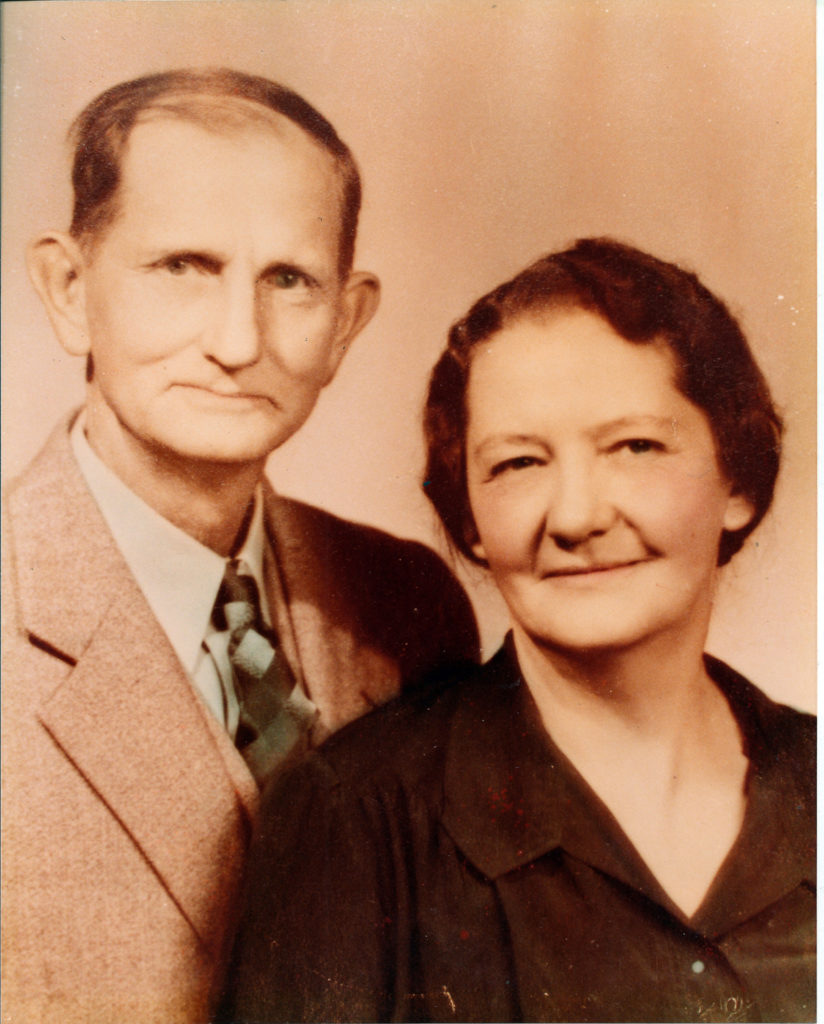

Eleven children were born to David Spencer Griffin, Sr., (born in 1796 in Kentucky) and Cynthia Burch (born in 1805 in NC). The couple had married in 1828 and lived in Bloomington, IN. In 1858, Spencer Griffin, who had lost his youngest daughter and been widowed in 1851, came to Texas with his six sons and four daughters to avoid the troubling times of the Civil War, crossing the Red River in ox wagons. They settled in Bandera County on the Verde Creek. Around the year 1870, Spencer Griffin settled with his oldest son, Hezekiah Griffin, Sr., (born in 1829), and his wife, Mary Jane Stevens, whom Hezekiah had met and married in Gainesville, TX, in 1861.
Over time, Hezekiah and Mary Jane moved their family to Bandera to escape constant terrorizing by the Indians; but, finding more of the same, in 1875, they moved further south to Medina County, west of what became the town of Devine (est. 1881), and built a log cabin – with fireplace and all – on land west of the Francisco Creek. Then, in 1890, Hezekiah and Mary Jane moved their family to a newly purchased 400-acre tract on the Castroville Road (FM 1343) and built a new home. There, Hezekiah worked as a farmer and rancher.
Seven children were born to Hezekiah and Mary Jane. Their seventh son was Ezra Spencer Griffin, born in 1876 “in the Blackjacks about two miles west of the Francisco Schoolhouse and Tolbert’s Mill.” He attended the Francisco School through “the sixth reader.” (From the memoirs of Arnold Griffin)
In 1905, Mary Katharine Arnold (born 1884), an orphan girl, went to teach at Shookville School and roomed and boarded with the family of Hezekiah and Mary Jane Griffin. At the end of that first year, she and Ezra Spencer Griffin married. They made their home on that land – known as the Shookville Community – where they remained until Ezra’s death.
Ezra, a farmer and rancher like his father, acquired two pieces of property, one a 440-acre tract and the other a 417+-acre tract, in addition to the home place which he had bought from the other heirs. Corn and red-top cane were grown to feed the cattle, but cotton was the “big cash crop” until the 1920s when the boll weevil ruined the cotton business. Then, corn became the main crop, and later, milo maize.
Ezra Griffin and Mary Katharine Arnold Griffin had four children: Leona Jewel, Mildred Allene, Arnold Stevens, and Edgar Allen, who died at the young age of twelve. Ezra, who was a trustee in Shookville School for many years, was a strong believer in a good education. Therefore, he wanted Leona Jewel to finish high school and attend college. So, in order to complete her education, she needed to attend her last three years in Devine High School. To do so, transportation was a problem, so, Ezra purchased a Model T Ford from Devine Motor Company. The salesman was August Schott, Jr., who had been a first-grade student of Mary Katharine. The agreement was that August would teach Mary Katharine how to drive. Reportedly, the car made the trip twice a day, despite the fact that the roads were often nearly impassable – just wagon roads with no caliches. Eventually, the Model T was replaced with a Model A, and the Model T was relegated to ranch use.
Meanwhile, Leona Jewel graduated and then attended Southwest Texas State Teachers College in San Marcos. She returned to Lytle where she taught high school Spanish. There, she met Marvin Paden Crouch, who had come from MO and was working in the Humble Oil Field. They married and had two boys: David (Dr. David Crouch, General Surgery and later Surgical Oncology) and Charles (Dr. Charles Crouch, DVM). The family built a home in Devine in 1951. Mildred Allene, who also earned her teaching certificate, moved to Langtry. While teaching there, she met Herbert Dodd. They subsequently settled in Uvalde.
Arnold Stevens Griffin, born July 5, 1916, attended school at Shook School Rural District #10 for eight years; then, he transferred to Devine where he graduated in 1933 in a class of 20 students. In the summer following graduation, Arnold worked for Houston Lively of Natalia, herding cattle on the irrigated project west and north of Natalia for .75 a day and board. He and another worker lived in a tent which was moved to follow the cattle. When fall came, Arnold attended Southwest Teachers’ College and then A&I College in Kingsville; however, he quit school because of the lack of funds.
Reflecting back on his childhood, one of Arnold’s fondest memories was in 1928 when he helped drive his dad’s herd of steers from the ranch into San Antonio to the Union Stock Yards. Arnold, his dad, Emil Bendele, Eugene Bendele, and Claude Griffin moved some 160 head up the road north through “the little town of LaCoste” and camped on the Medina River north of Von Ormy. They penned the steers in a hay field, along with a wagon load of fat hogs for market. They had a chuck box and bed rolls on top of the deck over the hogs. Arnold recorded, “We ate bacon and eggs cooked over a camp fire and moved out on the road at the break of day.” The trek took the herd though Kelly Field and Duncan Field – where a motorcyclist barreled out and stampeded the steers into the Belgian Gardens. But the men circled the herd and brought them back together and reached the back gate of the stockyards where the gates were opened just in time to let the train pass. “It was quite an experience for a twelve-year-old boy!” Arnold said.
After leaving college, Arnold became a carpenter and worked on building bridges and highways in several states. He lived in Harlingen during WWII and helped build the Harlingen Gunnery School. From there, he moved to Kingsville and did contract work on the King Ranch and also worked for the Humble Oil Company. In 1946, he moved back home to put his oldest daughter in School, and he built a new home on Highway 173, three miles N.W. of Devine, the home where he raised his family and lived until his death in 2001.
Arnold continued to work in building. He operated a lumber yard in Devine and did contracting business. He built some 300 homes in Devine, Hondo, and other places nearby. He built other structures as well, including Lucky Feed Lot and Cox Feed Lot in Devine, the Texas Marketing Association on Highway 90, the O. R. Mitchell Feed Lot at Von Ormy, and the Hugh Burns Mill at Dilley. In addition, Arnold continued to farm and ranch, as did his forefathers, all of his life, and to the credit of the Griffin legacy, he acquired eight ranches in Medina and Frio Counties.
In 1940, Arnold married Edna May Ward (born in 1917), the youngest daughter of Nobel Wesley Ward and Mary Alice Scoggins. They had five daughters: Mary Angela, Molly Sue, Leona Jewel, Helen Ruth, and Roberta Lynn. Active in his community, Arnold taught Veterans Agriculture in Devine following the end of WWII. He was a Baptist deacon at FBC Devine and taught adult Sunday school classes for 28 years. Arnold enjoyed hunting, playing the fiddle, welding, plumbing, carpentry, and bulldozer operating, among other things. He was a member of the Devine Music Makers, playing at the Devine Nursing Home and Country Care Center weekly. He proudly participated in the Texas Folklife Festival where he displayed the original tool chest which Spence Griffin brought across the Red River in 1858, including his shingle splitting tools and the rock saw that carved out stone used in St. Joseph’s Catholic Church of Devine. (When Arnold died, he had served for 30 years, for which he received a pendant. Rick and Ruthie Smith have continued the tradition, participating for 46 years this coming June.) Arnold owned the first self-propelled combine in Medina County, a purchase made through LaCoste Bank in 1947. He then began a land-clearing business – owning Cat D8s, International TD 18s, Cat 7s – a business he continued to enjoy all his life.
Arnold recorded this statement about his life: “I have lived in the horse and buggy days, farmed with mules and walking plows, broke wild horses, and lived through the automobile age and putting people on the moon. It’s a great age.” Three of Arnold’s and Edna’s daughters were teachers – Mary, Ruthie, and Roberta – each serving education some 30+ years. Molly (d. 2011) worked for CP&L for a number of years, and she raised and sold birds. And all five girls have made their home in Devine.
Arnold passed away in 2001. At this time, he is survived by eight grandchildren, 12 great-grandchildren, and one great-great-grandchild. He is buried alongside his wife, Edna (d. 2002), in Evergreen Cemetery in Devine. Arnold’s father, Ezra, died in 1955 while moving a herd of cattle at night near his home on Highway 173; he was hit by a car. He and his wife, Mary Katharine (d. 1974), are buried in Evergreen Cemetery. Ezra’s father (Arnold’s grandfather), Hezekiah, is buried, along with his wife, Mary Jane Stevens, in the Tomerlin Cemetery. It is located between Hwy 2200 and Moore. Hezekiah’s father, Spencer Griffin, Sr. (Arnold’s great-grandfather), is buried in the Griffin/Nolin Cemetery, located six miles east of Devine on what became the J. Travis Lilly land.
